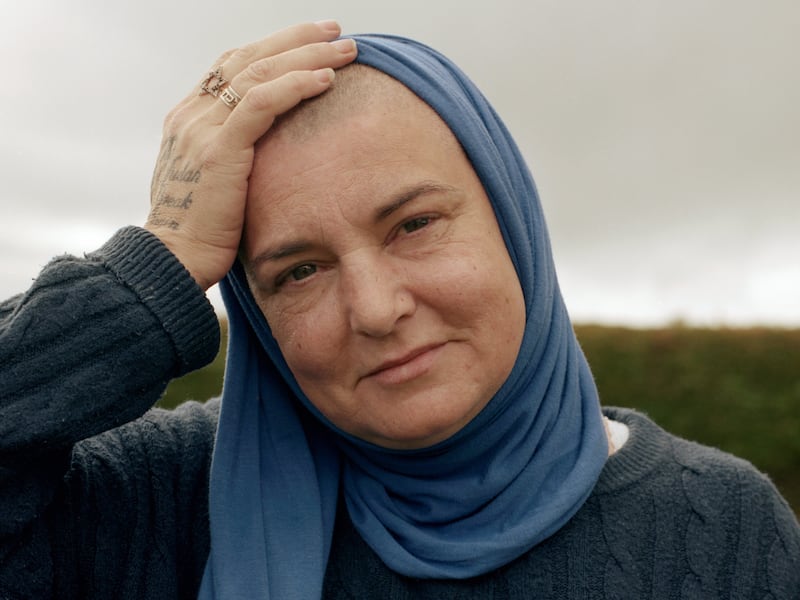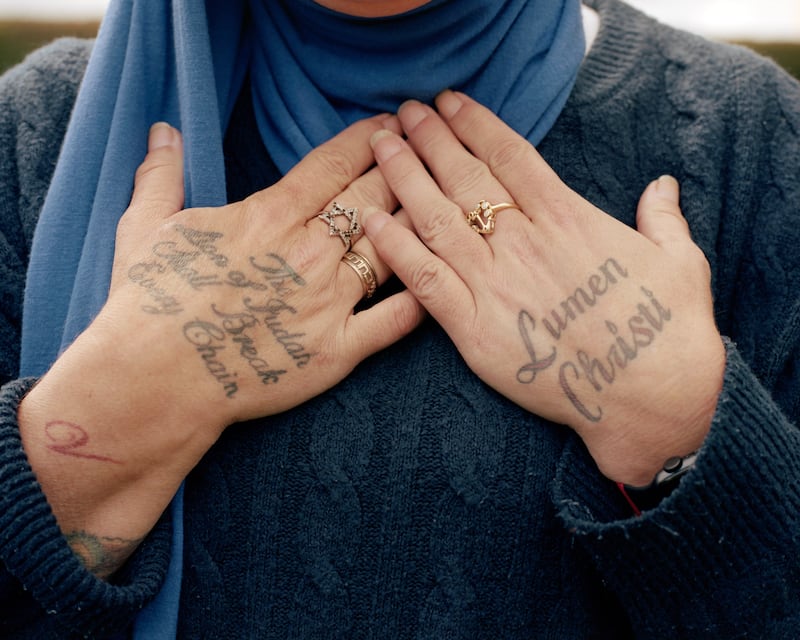There are so many clips but there’s one in particular I keep returning to now she’s gone. I found it online a few hours after news of her death broke. The sadness that lodged in my chest as I sat eating dinner in a restaurant on Wednesday evening with my daughters had by now settled deep in the pit of my stomach. When I got home I was filled with a desperate need to hear Sinéad O’Connor’s voice.
The clip is from The Late Late Show during the Gay Byrne era. It’s from Christmas Eve 1993, a year after she tore up that photo of the pope in protest against paedophilia in the Catholic Church, an action for which she was roundly condemned. This country would only begin to reckon with the widespread abuse she was pointing to in the years that came afterwards. It always took us far too long to catch up with Sinéad O’Connor.
Sinéad had been on the Late Late the week before and had, Gay informed his live audience, suggested she might record a song for him to play out on this special Christmas Eve show. Gay loved her, a fondness that seemed mutual. You could see it in the care and kindness and empathy he showed the singer in interviews over the years.
He introduced the recording and then, there she was, green dangly earrings, slightly crumpled silk top, microphone in hand. There was no musical accompaniment. Just Sinéad singing Danny Boy, her unique voice making that old and, to some ears, hackneyed song sound brand new.
READ MORE
And I shall hear, though soft you tread above me,
And all my grave will warmer, sweeter be,
For you will bend and tell me that you love me,
And I shall sleep in peace until you come to me.
Her voice is quivery and ethereal and it takes me back to the first time I heard her sing. It’s the winter of 1987 going into 1988. The battered cassette is on a shelf somewhere upstairs. The Lion and the Cobra. A debut of pure genius largely written when she was still a teenager and released when she was a pregnant 20-year-old about to give birth to her first child. Shaven-haired Sinéad O’Connor in a blue vest, screaming on the album cover. Dublin in a rainstorm. No other Troy for us to burn. I was one of those teenagers. Lying angry and rebellious on the bed with the curtains closed against the pale wintry light, blasting out Sinéad O’Connor. “And you should’ve left the light on,” she scream-sang. “You should’ve left the light on.”
We were young, female and Irish. We didn’t know what exactly was eating us or what to do with our demons. But when she sang, it felt like this girl from Glenageary might be able to show us the way. We only had to listen. So we listened. To the burning rage of Jerusalem. To Mandinka. What was a Mandinka when it was at home? It didn’t matter. It was poetic. It was powerful. It was intensely personal. “I don’t know no shame, I feel no pain. I can’t/ I don’t know no shame I feel no pain, I can’t see the flame.”
“Singers don’t feel shame,” Sinéad told me in the pandemic summer of 2021. We were in her home in Co Wicklow, giddy about being around people again. I was interviewing her for The Women’s Podcast about her beautifully written memoir Rememberings.
She told me she had a good dose of Catholic guilt having grown up “in a horrific theocracy”, but no shame. She put this down to the studio experience, where singers are watched in a dark room “and we’re mortified and we sound like cats getting dragged through the mud until we get it right”, she said, chain-smoking menthol cigarettes in her colourful and light-filled cottage. “We are no different off stage than on; a singer’s job is to be emotionally honest. All the greatest singers you can think of are singers who become the song, emotionally open and present.”

Sinéad was a fascinating conversationalist as well as being fantastically funny and sweary, sitting on a sofa covered by a Hindu goddess blanket. A “gobby bitch”, as she called herself. She spoke about dedicating the book to St Pat’s, the mental health service she’d spent time in over the past six years.
We were supposed to talk for an hour, but she was in no hurry and we spent more than two hours chatting and laughing about her life and times. She spoke of her pride in her children, her fierceness as a mother, particularly in relation to her vulnerable son Shane. “Anybody f**ks with that kid I will drive my motherf**king car through their door,” she said. He died by suicide last year, an unspeakable blow.
Nobody ever asked me what my dreams were, they just got mad at me for not being who they wanted me to be
— Sinéad O'Connor
Sinéad spoke about her own trauma as a child, her anger with her mother, which transformed into anger with the world and her “burning every bridge I ever crossed”. She spoke about how, in Ireland, the only role models were “the Virgin Mary, the Immaculate Conception, Sindy with her different outfits... A woman wasn’t allowed to be angry. Men could box the sh*t out of each other but we had to be nice and sweet”.
Which is why, of course, we needed Sinéad O’Connor showing us a different way to be a woman and giving two fingers to those narrow patriarchal expectations.
She spoke about her start in music and how she refused to collude with those who tried to make her beauty a bankable commodity, shaving her head on a whim when the male record company executives tried to get her to wear high heels and short skirts.
Deeply self-aware, she talked about her flaws and her triggers, about how when she felt bullied, “I become the biggest gangsta b*tch and rain down hell”. She told me how she had learned to live with the darker sides of herself, “to invite them in to have tea”.
Sinéad talked about the tearing of the photo of Pope John Paul II on Saturday Night Live. It had not, in fact, derailed her career, as some people mistakenly thought. She said the furore had put her back on the right track “as a protest singer”. The large hit that made her a superstar in 1990, Nothing Compares 2 U, “wasn’t supposed to happen... it shouldn’t have happened... I am a square peg in a round hole. I was inspired by protest singers when I was young, music that could change the world... nobody ever asked me what my dreams were, they just got mad at me for not being who they wanted me to be”.
For such a renowned celebrity she was unusually approachable, giving out her mobile number and email address, often answering queries no matter how random, sometimes reaching out to writers. As a very young reporter I’d written something she took issue with and she left a voice message on my work phone. I remember thinking that I’d never surpass the journalism accolade of being chastised via voice message by my musical hero.
What she saw in that institution, where older women from the Magdalene laundries were incarcerated in their old age, was formative
In 2014, when I was doing a feature asking well-known people to “ask Enda Kenny anything”, I emailed her to see if she had a question for the then taoiseach. First she had a comment: “Taoiseach, first of all I want to say I have a lot of admiration for you and I think you have balls the size of Alaska for standing up to the Church in the Dáil the way you did.” And then she also had a question: “In the early 1980s I was 14 and in a residential institution, An Grianán. I had a 17-year-old friend who was also a resident and in the care of the State. While there, she became pregnant. I saw the baby boy when he was born. She was forced against her will to give the child up for adoption. My question is, can you help trace this woman’s son and the other babies born to women in similar circumstances and taken away from them against their will?”
In many ways this question went to the heart of what propelled her art and humanity. What she saw in that institution, where older women from the Magdalene laundries were incarcerated in their old age, was formative. Sinéad never stopped talking about those women. She never stopped talking about all our dirty linen. She spoke publicly and unapologetically about having abortions. She spoke about child sexual abuse and the oppression of women and girls by the Church. She attended many protests and spoke about mental illness and racism and, more recently, about the sexualisation and grooming of young pop stars and music fans. She pointed at things most people were not ready to acknowledge, commanding that we not look away. And instead of being celebrated, she was mocked or dismissed or derided for far too long.
In the last few years it seemed as though Sinéad was finally getting her proper dues. Not just for her music – nobody could ever argue with that voice or with that extraordinary and diverse output – but for her fearless truth-telling and activism. Did she know how appreciated she was? I think so. Kathryn Ferguson’s 2022 documentary, Nothing Compares, puts her activism in context and clearly illustrates the brickbats she took for speaking out and refusing to fit in.

It also highlights the impact of her activism. She directly influenced my own decision to speak publicly about my abortion. I was at a party, having doubts and fears about telling my story, when a friend sat me down and played that video of her at the Bob Dylan tribute concert in Madison Square Garden. She was being booed on stage for having recently torn up that picture of the pope. She’d spoken out about the Church and now the punishment that would kill her commercial career in the US was unfolding. Sinéad stood firm on the stage, warrior-like and defiant in blue, facing down those who wanted to silence her. Even watching it decades later, her courage is contagious.
Her children, her family and her friends are grieving now, a private, unknowable grief. And then there is our public mourning. Did she really know? Did she understand how grateful we were, how loved she was? It’s important to many of us that when Sinéad O’Connor died, far too young at 56, she knew how much we admired her. How grateful we were for her trailblazing, her righteous anger, for her willingness to stick her head above the parapet without regard for, or fear of, the consequences.
[ Sinéad O’Connor’s 10 most important songs: From Mandinka to The Skye Boat SongOpens in new window ]
In the summer of 2021, when we’d finished the podcast interview about her memoir, I told her my children had been waiting with their father for me outside in the car. I was worried they’d be annoyed that I was late. Sinéad gave my pathetic mammy-guilt shrift and told me to remind the kids in no uncertain terms that I’d been busy working, earning money so they could have nice things. I told her we’d been singing her songs in the car on the way down from Dublin and asked would she mind saying hello to them.
The girls were immediately charmed by this smiley, cheeky woman in a headscarf. I told her they loved singing. Sinéad O’Connor stood, a girl on either side of her, listening to them sing like this was the most important song she’d ever heard. And that’s how I’m remembering her. On a quiet country road in the late evening summer sunshine, head bowed, listening carefully to my daughters sing Danny Boy. The song I keep returning to on The Late Late Show.
Rest easy Sinéad. And thank you for everything.

Nothing Compares: Sinead O'Connor’s Rememberings
In this podcast from 2021, Sinead O'Connor talks about her traumatic childhood, her singular musical career and the liberation she found in tearing up that photo of the pope

















